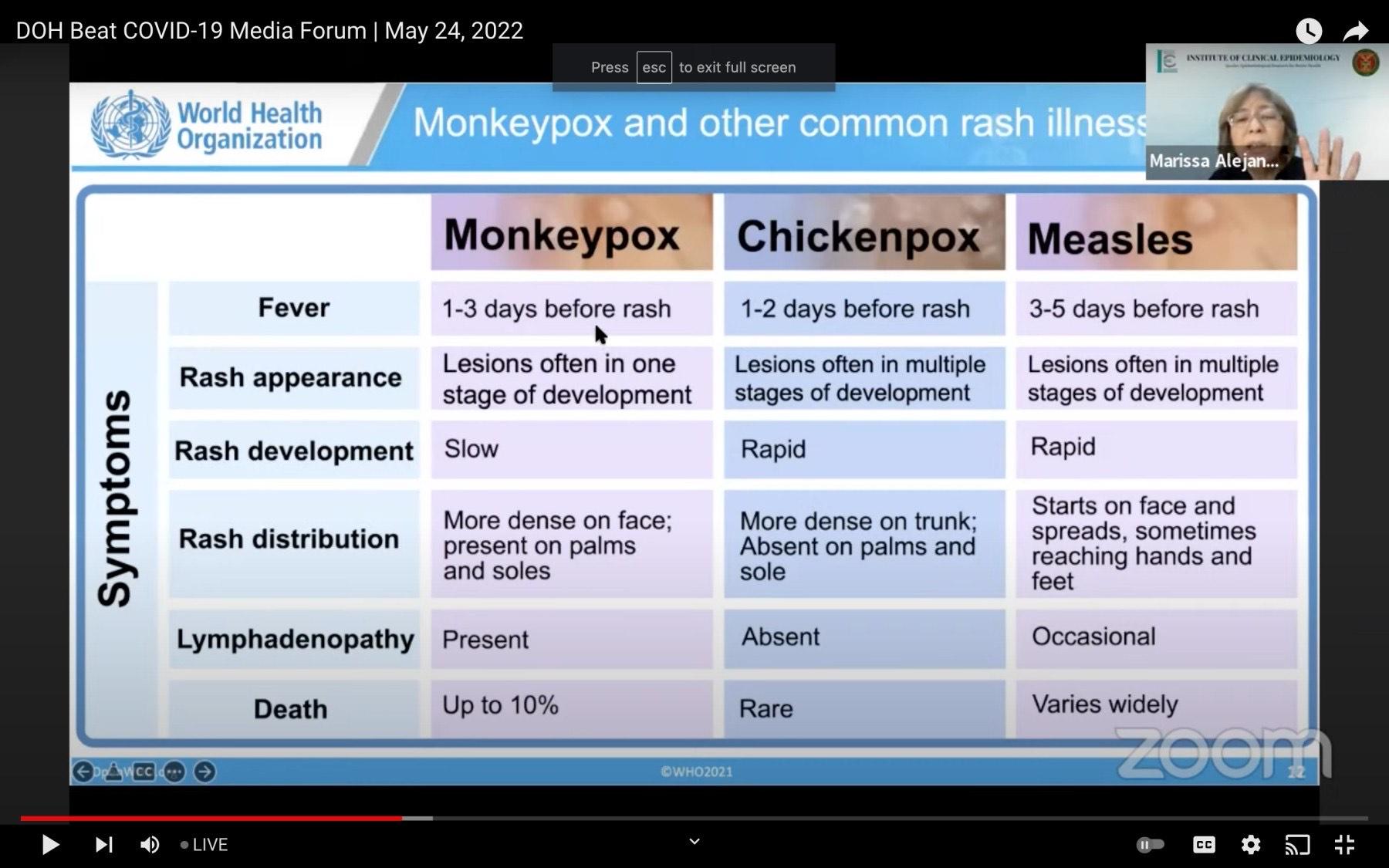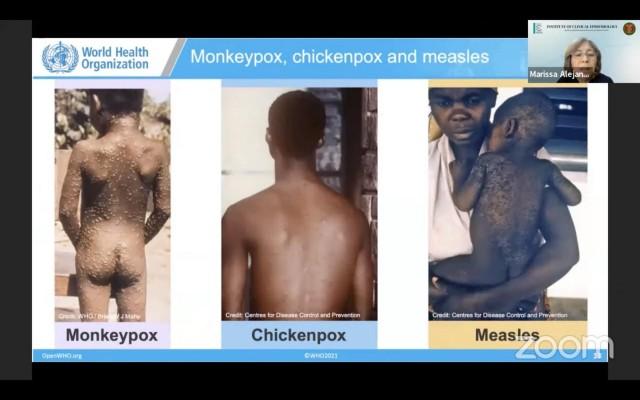What's the difference between monkeypox, chickenpox, and measles?

Though somewhat similar in appearance, the Department of Health (DOH) on Tuesday presented differences between the monkeypox, chickenpox, and measles amid the former's outbreak in non-endemic countries around the globe.
According to Dr. Marissa Alejandria of the DOH Technical Advisory Group, monkeypox is a viral zoonotic disease that can be transmitted from animals to people.
It is endemic or locally acquired in Africa while there are imported cases that have been reported in the United States, United Kingdom, and Israel.
Individuals may acquire monkeypox through contact with an infected animal, contaminated animal products, infected people, and mother to fetus transmission.
Specifically, Alejandria said monkeypox may be obtained through unprotected contact with respiratory droplets, lesion material, body fluids, and contaminated materials and surfaces.
The virus may enter the respiratory tract, eyes and mouth, and broken skin.
Individuals infected with monkeypox will suffer from fever one to three days before they develop rashes, according to Alejandria.
Meanwhile, those with chickenpox will experience fever one to two days before the rashes appear while those with measles will experience fever three to five days before the rashes develop.
For monkeypox, lesions often appear the same throughout the infection period while there are slight differences for chickenpox.
“Sa bulutong tubig, pwede magkakaiba. Meron parang pantal lang, meron iba may tubig na. Tapos sa measles naman… wala siyang rash na may tubig. Flat lang ‘yung sa measles na mapula. Parang pantal, parang allergy,” Alejandria said.
The rash development for monkeypox is considered to be slow while the development is rapid for both chickenpox and measles.

Alejandria said rashes are denser around the face area, palms, and soles for monkeypox while chickenpox rashes are denser on the body or trunk with none on the palms and soles.
Meanwhile, measles starts on the face area and spreads downwards.
“Tapos ‘yung enlarged lymph nodes o ‘yung kulani, sa monkeypox lang nakikita. So ‘yun ‘yung distinguishing feature ng monkeypox, compared sa chickenpox at saka measles,” she said.

According to Alejandria, the smallpox vaccine can protect against monkeypox.
“Yes, smallpox vaccine can protect against monkeypox. Kasi ‘yung virus that causes smallpox, monkeypox, magkakamag-anak ‘yang mga ‘yan, so may cross protection na tinatawag,” she said.
“It’s just that wala pa tayo ngayong supply ng vaccines, smallpox. There’s a small supply. Kasi nung na eradicate na ‘yung smallpox nung 1980s… wala nang masyadong production ng vaccine,” she added.
Health Epidemiology Bureau director Dr. Alethea de Guzman said monkeypox will be classified as a “notifiable disease,” meaning that all individuals under investigation must be reported to the Epidemiology Bureau and concerned units.
“Wala pa tayong kaso ng monkeypox pero makakaasa ang publiko na handa ang Kagawaran na tumugon sa health crisis na ito,” De Guzman said.
Despite this, De Guzman admitted there is a possibility for the virus to enter the country.
“Ayon sa risk assessment ng World Health Organization, may posibilidad talagang kumalat itong monkeypox na ito… kaya naman natin ginagawa itong mga paghahandang ito locally and at our borders,” she said.
“Gusto natin maging handa, una, by minimizing the risk na makapasok ang monkeypox sa bansa kaya natin hina-heigthen ang screening and surveillance sa ating borders. Pero locally, tayo ay naghahanda dahil meron naman talagang posibilidad na makapasok ang monkeypox,” she added.
Though Health Secretary Francisco Duque III said there is no need yet to close down the country’s borders, the Philippines has heightened surveillance and border controls to prevent the entrance of the disease.
Dr. Anna Ong-Lim of the DOH-TAG also stressed that COVID-19 remains to be the more alarming virus of the two.
“In as much as we’re all very concerned about this newly recognized disease, siguro I’d also like to highlight na kung pipili ako ng isang sakit na mas ikababahala ko, mas magiging concerned pa rin ako sa COVID kaysa sa monkeypox,” she said.
Though it is important for the public to be aware of the monkeypox virus, Ong-Lim said she hoped that the increase in cases will not go unnoticed.
“Kasi I think this is really the point that we want to focus on and it’s very important for people to be aware na dumadami na nga ang mga kaso and we need to do something very quickly,” she said.—AOL, GMA News





